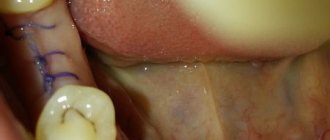After tooth extraction, a strong inflammatory process called alveolitis may occur in the gum socket. This disease affects about 25% of people who undergo tooth extraction operations. The main reason is the absence of a blood clot (thrombus), which protects the wound from infection. In severe cases, tooth inflammation can affect the jaw bones.
When you have a tooth removed, powerful wound healing processes are launched in your body. A blood clot forms in the open cavity of the socket, which preserves damaged tissue from mechanical stress and bacteria.
As a result of a lack of platelets in the blood, the protective clot may be destroyed prematurely. Food debris gets into an unprotected wound, which rots and causes alveolitis of the tooth.
Most often, alveolitis occurs in the sockets of removed wisdom teeth, or during complex operations to remove other teeth, when:
- The tooth crumbles when it is grabbed by instruments;
- Curvature or interweaving of tooth roots occurs;
- The supragingival part of the tooth is completely destroyed with the remaining tooth root.
In these cases, an operation is performed to cut the gums, or the fragments are removed using a drill. This can cause additional trauma, which can cause inflammation of the tooth.
Symptoms of inflammation
During the normal healing process, the pain after tooth extraction lasts 1-2 days, after which it gradually subsides, the wound becomes covered with a blood clot and heals over time. With inflammation, the pain can come in waves, not subside or even intensify. The nature of the pain is pulsating, can radiate to the ear, and manifests itself after eating. Does not respond to painkillers.
When examining yourself, pay attention to the following signs:
- the gums at the extraction site are red;
- the socket is dry, a blood clot does not form or is quickly destroyed;
- there is a gray or yellow coating;
- bleeding from the socket;
- increased body temperature;
- unpleasant taste and odor from the mouth;
- enlargement of the submandibular lymph nodes.
If at least one of the listed signs is present, you should consult a doctor. There is a suspicion of alveolitis.
Inflammation after tooth extraction
05.03.2020
Inflammation after tooth extraction
- Signs of inflammation after tooth extraction
- Causes of alveolitis
- Treatment of inflammation
Surgical treatment of dental pathology is associated with a violation of the integrity of the gum tissue and is almost always accompanied by pain.
Usually it gradually decreases and goes away within 1 to 2 days. With extensive interventions, the pain may persist longer, but also tends to subside. Another case is if inflammation occurs after tooth extraction.
Signs of inflammation after tooth extraction
In this case, the pain increases and can become pulsating. Sometimes the pain radiates to the ear on the affected side. Many patients refuse to eat because of pain. Strong in intensity, it is not relieved by taking analgesics. Such symptoms after tooth extraction are a signal that you need to visit the dentist. Otherwise, complications may develop in the form of inflammatory bone lesions (osteomyelitis of the jaw), periostitis.
Causes of alveolitis of the tooth socket
Scientifically, inflammation of the gums after tooth extraction is called alveolitis, that is, damage to the socket of an inflammatory nature. The cause of this gingivitis may be:
- General factors: decreased immunity, severe concomitant diseases, blood coagulation disorders, exhaustion after infections, vitamin deficiency, old age;
- Local: drinking hot drinks and food soon after the dental procedure, intensive rinsing, transfer of the pathological process to the gum tissue from neighboring areas in case of severe caries.
All this leads to the fact that the healing process of the wound surface is disrupted. Normally, the consequence of the operation is the formation of a loose blood clot. It fills the space inside the hole, where loose, and later dense, connective tissue gradually grows. Inflammation most often occurs after the removal of a wisdom tooth. This is due to the fact that such operations are especially traumatic: they affect the bone structures of the jaw and damage many small vessels.
Treatment of gum inflammation
If alveolitis occurs, treatment should be carried out by a specialist.
When examining the oral cavity after tooth extraction, alveolitis is diagnosed if:
- redness of the edges of the hole;
- absence of blood clot;
- severe pain of the wound;
- gray or yellow coating.
Solid food debris, small fragments of bone and teeth can inflame the wound surface. Careful inspection and removal of foreign bodies, washing the wound with antiseptics and antibiotic solutions create conditions favorable for healing. A tampon soaked in a medicinal solution is placed into the hole.
If necessary, general treatment is prescribed: analgesics, physiotherapeutic procedures. Sometimes it is recommended to make local baths with antimicrobial drugs.
Inflammation of the gums after removal does not indicate poor quality of services. This may be due to the individual characteristics of the patient's body. It is important to understand: if the area continues to hurt for more than 2 days, you need to resort to dental services. Another conclusion is that it is better to treat oral diseases (periodontitis, caries) before surgery. Then, after the procedure, there is less risk that the patient will suffer from toothache or complications will develop.
Causes of alveolitis
- During tooth extraction, tissues are severely injured.
- Reduced immunity.
- Blood clotting disorder.
- Intensive rinsing and drinking hot liquids immediately after tooth extraction.
- Elderly age.
- Infection of the hole from neighboring tissues and teeth (for example, in the case of caries in the neighborhood).
- The presence of other diseases of the body at the time of tooth extraction.
- The rest of the root is in the hole.
- Hard pieces of food getting into the wound.
- Insufficient oral hygiene.
- Smoking.
- Creating a vacuum in the mouth (for example, when using a drinking straw).
Most often, alveolitis appears as a result of the removal of “eights”. Since this is a large element, it affects many vessels, which makes healing of the gums after wisdom tooth removal difficult.
Natural processes
Even if the tooth extraction was “simple”, pain in the socket at the site of the extracted tooth is a natural consequence that will bother you for 3-4 days.
This is normal and nothing to worry about, but if the pain causes you severe discomfort, consult your doctor and he will recommend that you take painkillers.
Sometimes regular cold compresses applied to the cheek in the area of the extracted tooth will help relieve pain. This could be a cloth soaked in cold water or ice from the freezer wrapped in a cloth.
Tooth socket
In the case of “complex removal”, in which the gums were cut and sutured, special tools were used to gouge out the root, the pain after the procedure will be felt much longer (the doctor will definitely warn you about this), but will still gradually go away on its own.
If the pain does not go away for more than ten days, consult your doctor: there may be complications in the tooth extraction and you will need dental intervention to eliminate them.
Treatment and prevention of alveolitis
Treatment of alveolitis is carried out by a dentist; self-medication is unacceptable. Firstly, you may make a mistake with the diagnosis, as a result all manipulations will be ineffective. Secondly, traditional methods are not enough, and for professional ones you do not have enough experience and equipment.
How is treatment carried out at the clinic? The doctor numbs the wound, cleans it, and puts a tampon with medicine. If foreign bodies (shards of tooth, root, pieces of food) prevent the socket from healing, the dentist removes them. You may need to take antibiotics, undergo physical therapy, baths with medications, and follow a diet during healing (excluding hard, hot foods from the diet). In advanced cases, additional operations are required. Traditional methods are acceptable with the permission of a doctor. For example, rinses with sage, chamomile, burdock and others. These solutions can accelerate tissue healing and alleviate the patient's condition.
What measures exist to prevent inflammation? In the first days, do not eat hard or too hot foods, and do not rinse your mouth. These actions help flush out the clot, which can cause inflammation. If tooth extraction is not an emergency, it is advisable to take care of the treatment of caries and other oral diseases in advance. Give up bad habits during healing: alcohol thins the blood, which prevents the formation of a clot, tobacco increases the risk of infection of the hole. If your gums hurt on the first day after tooth extraction, you can simply take a painkiller.
Two days after tooth extraction, the pain has not subsided, it has intensified, and its character has changed, which means that you should definitely consult a doctor! Alveolitis does not go away on its own; it can only lead to unpleasant consequences and complicate further treatment. Monitor the condition of your teeth especially carefully if there were other diseases of the oral cavity or the body as a whole at the time of removal. Doctors at Comfort Dentistry give recommendations for further care after tooth extraction. They tell you how to treat gums after tooth extraction, and in what cases to contact a dentist. If you doubt the correctness of self-diagnosis, you can call us and consult with a specialist.
Treatment of alveolitis
This disease cannot be treated independently, as incorrect treatment methods can cause complications. Therefore, if you suspect tooth inflammation after extraction, you should make an appointment with a dentist. To cure alveolitis you need to:
- Remove all foreign bodies from the socket cavity. The doctor applies anesthesia to the gum and cleans the walls of the socket.
- Placement of an antiseptic drug into the tooth socket.
- Taking antibiotics and painkillers. Depending on the development of alveolitis, the necessary drugs for treatment are selected.
- Application of dental pastes. Used 2 days after the main treatment, it accelerates the healing process and relieves pain.
Many people try to cure inflammation of the socket using antibiotics. But this treatment method is ineffective. Treatment of alveolitis must be carried out comprehensively, and the main measure that only a doctor can take is the removal of pus from the cavity of the socket.
How to get rid of pain at home
To eliminate postoperative pain, the dentist will prescribe analgesics and cold compresses on the side of the intervention. Additionally, you can use traditional methods - mouth baths made from tinctures or herbal decoctions. Baths with an antiseptic drug are also allowed (the solution must be held in the mouth for a while and spat out). What is strictly forbidden:
- warm the operated area;
- rinse your mouth intensively (you can wash out the blood clot);
- chew on the injured side;
- “check” the hole using your tongue, fingers, and apply medicine to it.
The risk of complications depends on the complexity of the operation to remove a dental unit. Simple extraction is carried out if the tooth does not have strong, intertwined roots, it is intact, and there are no associated problems (cysts, pulpitis, periodontitis, etc.).
Extraction of dystopic teeth, which are very crooked, have intertwined, crooked roots, with a destroyed coronal part, and with an inflammatory process, is considered difficult. In such cases, a more extensive operation may be necessary with a preliminary incision in the gum, sawing the tooth into elements, extracting fragments through a hole in the jaw bone, and applying sutures. Molars are usually difficult to remove. If your gums hurt for several days after the removal of a molar, but the painful symptoms are smoothed out, then the wound is healing normally.
Healing of the extracted tooth socket
METROGYL DENTA® is used for complex treatment and prevention of post-extraction alveolitis (inflammation of the socket after tooth extraction). The use of the drug helps eliminate inflammation by suppressing the activity of pathogens inhabiting the oral cavity. To prevent post-extraction alveolitis, the tooth socket after extraction is treated with METROGIL DENTA® gel and then the drug is applied for 7-10 days 2-3 times a day. METROGYL DENTA® has a good safety profile and is suitable for the treatment of periodontal diseases and mucous membranes of the cavity, starting from the age of 18.
Up to contents
The information in this article is for reference only and does not replace professional advice from a doctor. To make a diagnosis and prescribe treatment, consult a qualified specialist.











